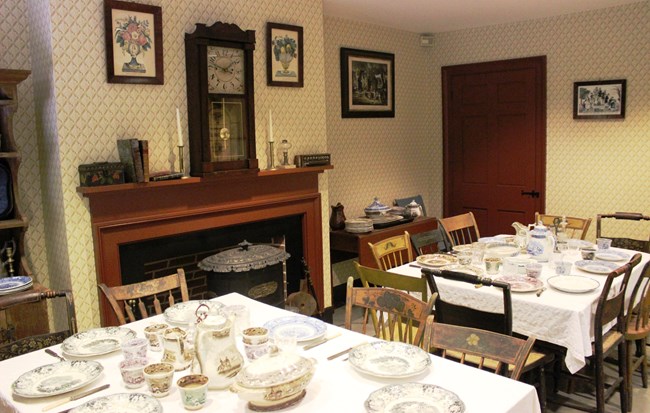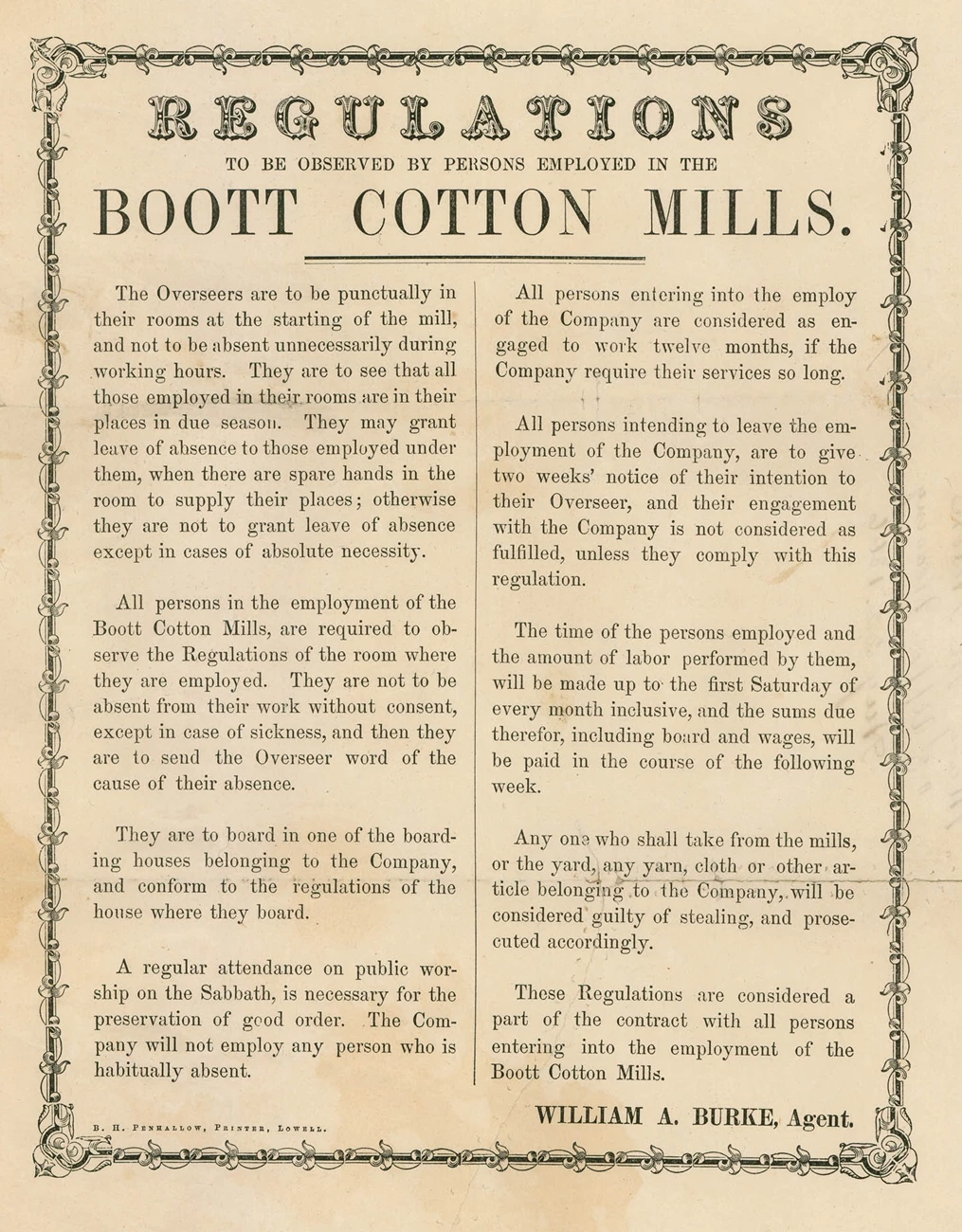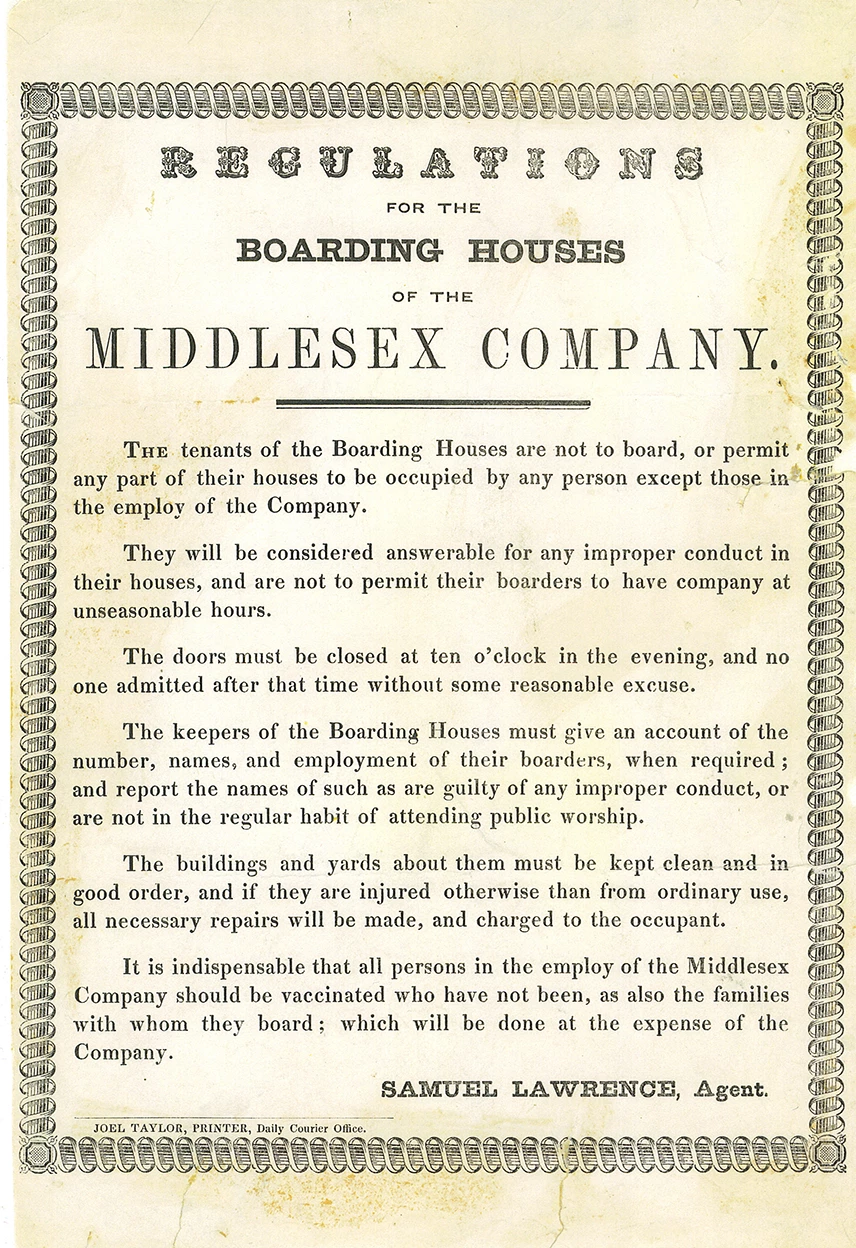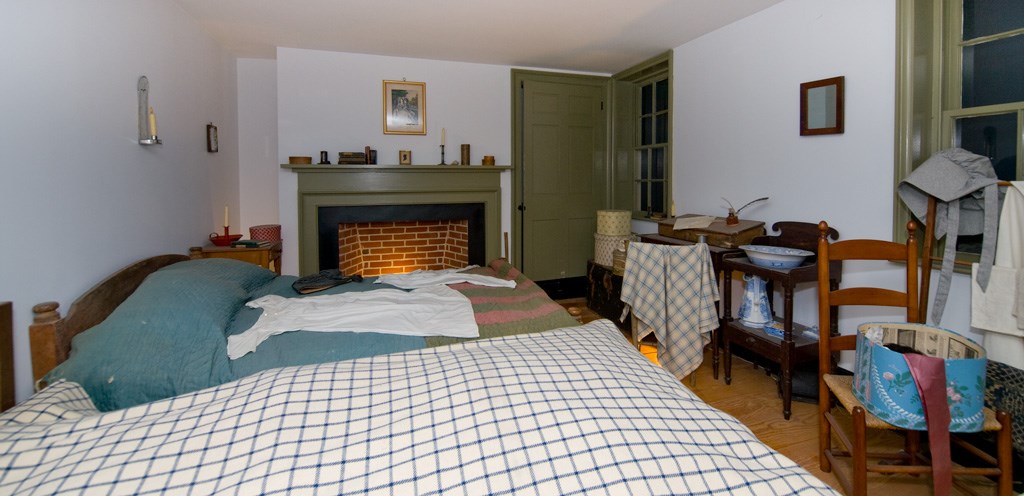Part of a series of articles titled Lyddie - Books to Parks.
Article
Lyddie: Chapter 08 - Number 5, Concord Corporation

Photo courtesy of Lowell National Historical Park
Lyddie wakes up the next day to the life of a mill girl. It is very noisy in the boardinghouse and in Lyddie’s attic room, which she shares with five other girls. It’s so loud, her first thought is that the bear had returned, before she remembers where she is. After the others have left for the mill, Lyddie goes downstairs to help the keeper, Mrs. Bedlow. When the girls return for their breakfast, Lyddie is introduced to Amelia, Betsy, and Prudence. Amelia and Prudence insist on taking Lyddie out shopping so she can replace her old clothes with new, city clothes. Mrs. Bedlow tells her the mills won’t hire her if she doesn’t get new clothes, so Lyddie reluctantly agrees and spends the last of Triphena’s money on a new dress and boots. (see chapter 3, Fact Check Mill Workers and Fancy Clothes)
Later that evening, Mrs. Bedlow tells Lyddie that she’s switching her room. Lyddie will now be living on the third floor with Amelia, Prudence, and Betsy. Lyddie is shocked to learn that there are rules while living at the boardinghouse, which is considered part of the mill. All mill workers are expected to attend church on Sunday, and be in bed by 10:00 pm. The next day Mrs. Bedlow takes Lyddie to the mill to ask for a job. Lyddie is given a one-year contract to work for the Concord Corporation. Soon, she is ready to begin her job in the weaving room.
Fact Check: Boardinghouse Rules
Were there rules for living in the boardinghouses?
What do we know?
Workers were given regulations for both working in the mill, and for living in the boardinghouse. Mill management wanted to maintain control over all aspects of their workers’ lives. Church attendance was required, doors to the boardinghouses were closed and locked at 10:00 pm every night, and workers were expected to behave in a ‘moral’ manner. These rules were designed for the benefit of the management, who wanted well-rested, obedient workers. But the regulations also eased parents’ fears about sending their daughters to the factory city. Knowing they would have a boardinghouse to live in, with a keeper to watch over their every move, may have convinced some parents to allow their daughters to seek out factory life. Above all, the regulations were established to ensure that Lowell would not become like Manchester, England, a manufacturing city where workers lived and worked in dirty and unhealthy conditions. Lowell was designed to be a model city that could never become like Manchester. The rules were part of how the owners hoped to accomplish their goal.
What is the evidence?
Primary Source:

Lowell National Historical Park

Lowell National Historical Park
Primary Source:
Excerpt from a letter written by Mary S. Paul to her father,
April 12th 1846
“ I have a very good boarding place have enough to eat and that which is good enough. The girls are all kind and obliging. The girls that I room with are all from Vermont and good girls too. Now I will tell you about our rules at the boarding house. We have none in particular except that we have to go to bed about 10. o'clock. At half past 4 in the morning the bell rings for us to get up and at five for us to go into the mill. At seven we are called out to breakfast are allowed half an hour between bells and the same at noon till the first of May when we have three quarters [of an hour] till the first of September. We have dinner at half past 12 and supper at seven. "
Excerpt from a letter written by Mary S. Paul to her father,
April 12th 1846
Center for Lowell History.
SecondarySource :
“Company-owned boardinghouses were leased out to older women who managed them as communal homes, providing meals and laundry service for the young girls, who were generally aged thirteen to twenty-two. So were born the ‘Lowell Mill Girls,’ an enlightened group of factory workers if there ever was one. These were good girls who only thought of hard work and proper behavior. The companies reassured reluctant parents with carefully supervised boardinghouses, strict rules, and just as carefully cultivated self-governance through social peer pressure.”
Pershey, Edward Jay. “Lowell and the Industrial City in Nineteenth-Century America.” OAH Magazine of History 5, no. 2 (1990): 5–10.
Fact Check: Water for the mills
Mrs. Bedlow tells Lyddie she thinks the “girls will be home for breakfast early. The river’s too high and the mill wheels are likely slowing. It means a holiday for them…” Why was water important in the mills, and why was too much water bad?
What do we know?
When the mills of Lowell were built, people did not yet know how to harness and use electricity, but the machines in the factories needed a lot of power. The thousands of machines in the city ran on water power, and all that water came from the Merrimack River. Waterpower works when falling water hits a waterwheel and makes it turn. The turning wheel then makes gears, pulleys, and belts turn. The turning belts are attached to machines to provide power. Before the first mill started operation in Lowell, early investors built a dam on the Merrimack River. The dam forced all the water from the Merrimack River into canals that carried the water directly to the mills, where the water entered the basements to turn the giant waterwheels. When there was too much water in the river, the water from the flooded river made its way into the basements of the mills and flooded the waterwheels. The wheels could not spin underwater, and the mills would have to cease operations until the river water receded.
What is the evidence?
Secondary Source:
“The tremendous waterpower potential of the site (Pawtucket Falls)…attracted a massive surge of capital investment, beginning in 1821…[the area was transformed] into a booming center for textile production and machine building. The canal system that they created, expanded, and continually improved was the principal supplier of power for Lowell’s corporations…
Backwater occurred whenever streams, swelled by rain or snowmelt, rose to flood the wheelpits of mills along their banks. Waterwheels lost efficiency or slowed to a halt when they had to turn through high water.”
Malone, Patrick, Waterpower in Lowell, Baltimore: The Johns Hopkins University Press, 2009.

Voices from the Field
"Food in New England" by Keith Stavely and Kathleen Fitzgerald, experts in New England and American food history.
United Tastes: The Making of the First American Cookbook (University of Massachusetts Press, 2017); Northern Hospitality: Cooking by the Book in New England (University of Massachusetts Press, 2011); and America's Founding Food: The Story of New England Cooking (University of North Carolina Press, 2004.)

Voices from the Field
"The Keeper of the House" by Tess Shatzer, Supervisory Park Ranger, Lowell National Historical Park.
Photos & Multimedia

The Mill Girls of Lowell
Learn about the choices the mill girls had to face
https://www.nps.gov/lowe/learn/historyculture/the-mill-girls-of-lowell.htm
Lowell National Hisotrical Park
Learn about life in the boardinghouse.
https://www.youtube.com/watch?v=8Xbo9IC_PY4
Tsongas Industrial History Center
See it yourself
Visit a real boardinghouse to see how mill girls like Lyddie lived at Lowell National Historical Parkwww.nps.gov/lowe
Writing Prompts
Opinion
Why did Mrs. Bedlow think her brother the stagecoach driver would not help the passengers push the stagecoach out of the mud? Use precise language that are supported by facts and details.
Informative/explanatory
How did Lyddie describe the meals that she took with the other girls in the boardinghouse? Include specific details.
Narrative
Lyddie could not read the boardinghouse regulations; therefore, she did not know what the keeper or the company expected of her. How did she feel every time she learned a new rule? Use precise language that are supported by facts and details.
Last updated: December 7, 2024


